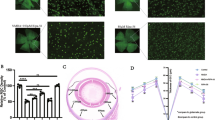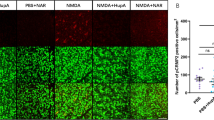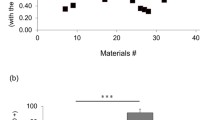Abstract
A preferential loss of retinal ganglion cells (RGCs) is observed in glaucoma and optic neuritis. Loss of tropomyosin-related kinase receptor B (TrkB)-mediated signaling has been implicated in this degeneration. Our study indicates that 7,8-dihydroxyflavone (7,8 DHF) robustly upregulates the TrkB signaling in the primary rat RGCs and the retinal neuronal precursor RGC-5 cell line by promoting phosphorylation of TrkB receptor, leading to enhanced TrkB receptor tyrosine kinase activity. The flavonoid derivative 7,8 DHF acts a potent TrkB agonist and upregulates the downstream AKT and MAPK/ERK survival signaling pathways in a TrkB-dependent manner in both primary rat RGCs as well as the RGC-5 cell line. Excitotoxicity and oxidative injury have been alleged in the specific RGC degeneration in various forms of glaucoma. A novel finding of this study is that treatment with 7,8 DHF protects these cells significantly from excitotoxic and oxidative stress-induced apoptosis and cell death. 7,8 DHF also promotes neuritogenesis by stimulating neurite outgrowth, suggesting a possible therapeutic strategy for protection of RGCs in various optic neuropathies.








Similar content being viewed by others
References
Almasieh M, Wilson AM, Morquette B, Cueva Vargas JL, Di Polo A (2012) The molecular basis of retinal ganglion cell death in glaucoma. Prog Retin Eye Res 31:152–181
Andero R, Daviu N, Escorihuela RM, Nadal R, Armario A (2012) 7,8-dihydroxyflavone, a TrkB receptor agonist, blocks long-term spatial memory impairment caused by immobilization stress in rats. Hippocampus 22:399–408
Bai Y, Xu J, Brahimi F, Zhuo Y, Sarunic MV, Saragovi HU (2010) An agonistic TrkB mAb causes sustained TrkB activation, delays RGC death, and protects the retinal structure in optic nerve axotomy and in glaucoma. Invest Ophth Vis Sci 51:4722–4731
Butowt R, von Bartheld CS (2005) Anterograde axonal transport of BDNF and NT-3 by retinal ganglion cells: roles of neurotrophin receptors. Mol Cell Neurosci 29:11–25
Cazorla M, Jouvenceau A, Rose C, Guilloux JP, Pilon C, Dranovsky A, Premont J (2010) Cyclotraxin-B, the first highly potent and selective TrkB inhibitor, has anxiolytic properties in mice. PLoS One 5:e9777
Chen J, Chua KW, Chua CC, Yu H, Pei A, Chua BH, Hamdy RC, Xu X, Liu CF (2011) Antioxidant activity of 7,8-dihydroxyflavone provides neuroprotection against glutamate-induced toxicity. Neurosci Lett 499:181–185
Cheng L, Sapieha P, Kittlerova P, Hauswirth WW, Di Polo A (2002) TrkB gene transfer protects retinal ganglion cells from axotomy-induced death in vivo. J Neurosci 22:3977–3986
Cheung W, Guo L, Cordeiro F (2008) Neuroprotection in glaucoma: drug-based approaches. Optom Vis Sci 85:E406–E416
Colafrancesco V, Parisi V, Sposato V, Rossi S, Russo MA, Coassin M, Lambiase A, Aloe L (2011) Ocular application of nerve growth factor protects degenerating retinal ganglion cells in a rat model of glaucoma. J Glaucoma 20:100–108
Dahlmann-Noor AH, Vijay S, Limb GA, Khaw PT (2010) Strategies for optic nerve rescue and regeneration in glaucoma and other optic neuropathies. Drug Discov Today 15:287–299
Devi L, Ohno M (2012) 7,8-dihydroxyflavone, a small-molecule TrkB agonist, reverses memory deficits and BACE1 elevation in a mouse model of Alzheimer's disease. Neuropsychopharmacology 37:434–444
Di Polo A, Aigner LJ, Dunn RJ, Bray GM, Aguayo AJ (1998) Prolonged delivery of brain-derived neurotrophic factor by adenovirus-infected Muller cells temporarily rescues injured retinal ganglion cells. Proc Natl Acad Sci U S A 95:3978–3983
Duncan RS, Xin H, Goad DL, Chapman KD, Koulen P (2011) Protection of neurons in the retinal ganglion cell layer against excitotoxicity by the N-acylethanolamine, N-linoleoylethanolamine. Clin Ophthalmol 5:543–548
Gupta VK, Rajala A, Daly RJ, Rajala RV (2010) Growth factor receptor-bound protein 14: a new modulator of photoreceptor-specific cyclic-nucleotide-gated channel. EMBO Rep 11:861–867
Gupta VK, You Y, Klistorner A, Graham SL (2012a) Focus on molecules: Sphingosine 1 phosphate (S1P). Exp Eye Res 103:119-120
Gupta VK, You Y, Klistorner A, Graham SL (2012b) Shp-2 regulates the TrkB receptor activity in the retinal ganglion cells under glaucomatous stress. Biochim Biophys Acta 1822:1643–1649
Harada C, Harada T, Quah HM, Namekata K, Yoshida K, Ohno S, Tanaka K, Parada LF (2005) Role of neurotrophin-4/5 in neural cell death during retinal development and ischemic retinal injury in vivo. Invest Ophth Vis Sci 46:669–673
Ito M (2003) Insulin or bFGF and C2 ceramide increase newborn rat retinal ganglion cell survival rate. Biochem Biophys Res Commun 301:564–571
Iwabe S, Moreno-Mendoza NA, Trigo-Tavera F, Crowder C, Garcia-Sanchez GA (2007) Retrograde axonal transport obstruction of brain-derived neurotrophic factor (BDNF) and its TrkB receptor in the retina and optic nerve of American Cocker Spaniel dogs with spontaneous glaucoma. Vet Ophthalmol 10(suppl 1):12–19
Jang SW, Liu X, Chan CB, France SA, Sayeed I, Tang W, Lin X, Xiao G, Andero R, Chang Q, Ressler KJ, Ye K (2010a) Deoxygedunin, a natural product with potent neurotrophic activity in mice. PLoS One 5:e11528
Jang SW, Liu X, Yepes M, Shepherd KR, Miller GW, Liu Y, Wilson WD, Xiao G, Blanchi B, Sun YE, Ye K (2010b) A selective TrkB agonist with potent neurotrophic activities by 7,8-dihydroxyflavone. Proc Natl Acad Sci U S A 107:2687–2692
Jelsma TN, Friedman HH, Berkelaar M, Bray GM, Aguayo AJ (1993) Different forms of the neurotrophin receptor trkB mRNA predominate in rat retina and optic nerve. J Neurobiol 24:1207–1214
Kay JN, De la Huerta I, Kim IJ, Zhang Y, Yamagata M, Chu MW, Meister M, Sanes JR (2011) Retinal ganglion cells with distinct directional preferences differ in molecular identity, structure, and central projections. J Neurosci 31:7753–7762
Kermer P, Klocker N, Labes M, Bahr M (2000) Insulin-like growth factor-I protects axotomized rat retinal ganglion cells from secondary death via PI3-K-dependent Akt phosphorylation and inhibition of caspase-3 In vivo. J Neurosci 20:2–8
Klocker N, Kermer P, Weishaupt JH, Labes M, Ankerhold R, Bahr M (2000) Brain-derived neurotrophic factor-mediated neuroprotection of adult rat retinal ganglion cells in vivo does not exclusively depend on phosphatidyl-inositol-3'-kinase/protein kinase B signalling. J Neurosci 20:6962–6967
Levin LA (2007) Axonal loss and neuroprotection in optic neuropathies. Can J Ophthalmol 42:403–408
Liu X, Chan CB, Jang SW, Pradoldej S, Huang J, He K, Phun LH, France S, Xiao G, Jia Y, Luo HR, Ye K (2010) A synthetic 7,8-dihydroxyflavone derivative promotes neurogenesis and exhibits potent antidepressant effect. Journal of medicinal chemistry
Ma CH, Taylor JS (2010) Trophic responsiveness of purified postnatal and adult rat retinal ganglion cells. Cell Tissue Res 339:297–310
Martin KR, Quigley HA, Zack DJ, Levkovitch-Verbin H, Kielczewski J, Valenta D, Baumrind L, Pease ME, Klein RL, Hauswirth WW (2003) Gene therapy with brain-derived neurotrophic factor as a protection: retinal ganglion cells in a rat glaucoma model. Invest Ophth Vis Sci 44:4357–4365
O'Neill EC, Danesh-Meyer HV, Connell PP, Trounce IA, Coote MA, Mackey DA, Crowston JG (2010) The optic nerve head in acquired optic neuropathies. Nat Rev Neurol 6:221–236
Pang IH, Zeng H, Fleenor DL, Clark AF (2007) Pigment epithelium-derived factor protects retinal ganglion cells. BMC Neurosci 8:11
Pease ME, McKinnon SJ, Quigley HA, Kerrigan-Baumrind LA, Zack DJ (2000) Obstructed axonal transport of BDNF and its receptor TrkB in experimental glaucoma. Invest Ophth Vis Sci 41:764–774
Sclabas GM, Fujioka S, Schmidt C, Li Z, Frederick WA, Yang W, Yokoi K, Evans DB, Abbruzzese JL, Hess KR, Zhang W, Fidler IJ, Chiao PJ (2005) Overexpression of tropomysin-related kinase B in metastatic human pancreatic cancer cells. Clin Cancer Res 11:440–449
Slon-Usakiewicz JJ, Dai JR, Ng W, Foster JE, Deretey E, Toledo-Sherman L, Redden PR, Pasternak A, Reid N (2005) Global kinase screening. Applications of frontal affinity chromatography coupled to mass spectrometry in drug discovery. Anal Chem 77:1268–1274
Tonges L, Ostendorf T, Lamballe F, Genestine M, Dono R, Koch JC, Bahr M, Maina F, Lingor P (2011) Hepatocyte growth factor protects retinal ganglion cells by increasing neuronal survival and axonal regeneration in vitro and in vivo. J Neurochem 117:892–903
Van Bergen NJ, Wood JP, Chidlow G, Trounce IA, Casson RJ, Ju WK, Weinreb RN, Crowston JG (2009) Recharacterization of the RGC-5 retinal ganglion cell line. Invest Ophth Vis Sci 50:4267–4272
Wan XZ, Li B, Li YC, Yang XL, Zhang W, Zhong L, Tang SJ (2012) Activation of NMDA receptors upregulates a disintegrin and metalloproteinase 10 via a Wnt/MAPK signalling pathway. J Neurosci 32:3910–3916
Xiao J, Wong AW, Willingham MM, van den Buuse M, Kilpatrick TJ, Murray SS (2010) Brain-derived neurotrophic factor promotes central nervous system myelination via a direct effect upon oligodendrocytes. Neuro-Signals 18:186–202
You Y, Klistorner A, Thie J, Gupta VK, Graham SL (2012a) Axonal loss in a rat model of optic neuritis is closely correlated with visual evoked potential amplitudes using electroencephalogram-based scaling. Invest Ophthalmol Vis Sci 53:3662
You Y, Thie J, Klistorner A, Gupta VK, Graham SL (2012b) Normalization of visual evoked potentials using underlying electroencephalogram levels improves amplitude reproducibility in rats. Invest Ophth Vis Sci 53:1473–1478
Zeng Y, Tan M, Kohyama J, Sneddon M, Watson JB, Sun YE, Xie CW (2011) Epigenetic enhancement of BDNF signalling rescues synaptic plasticity in aging. J Neurosci 31:17800–17810
Zhang XH, Guo XN, Zhong L, Luo XM, Jiang HL, Lin LP, Ding J (2007) Establishment of the active catalytic domain of human PDGFRbeta tyrosine kinase-based ELISA assay for inhibitor screening. Biochim Biophys Acta 1770:1490–1497
Zhang R, Kang KA, Piao MJ, Ko DO, Wang ZH, Chang WY, You HJ, Lee IK, Kim BJ, Kang SS, Hyun JW (2009) Preventive effect of 7,8-dihydroxyflavone against oxidative stress induced genotoxicity. Biol Pharm Bull 32:166–171
Zhang F, Kang Z, Li W, Zhou X (2012) Roles of brain-derived neurotrophic factor/tropomyosin-related kinase B (BDNF/TrkB) signalling in Alzheimer's disease. J Clin Neurosci 19:946–949
Zheng J, Feng X, Hou L, Cui Y, Zhu L, Ma J, Xia Z, Zhou W, Chen H (2011) Latanoprost promotes neurite outgrowth in differentiated RGC-5 cells via the PI3K-Akt-mTOR signalling pathway. Cell Mol Neurobiol 31:597–604
Acknowledgments
Support funds from the Ophthalmic Research Institute of Australia, National Multiple Sclerosis Society, Multiple Sclerosis Research Australia, and MQNS grant are gratefully acknowledged. RGC-5 cells were kindly provided by Prof. Al-Ubaidi, University of Oklahoma. VG was supported by funding from Allergan Australia.
Author information
Authors and Affiliations
Corresponding author
Additional information
Vivek K. Gupta, Yuyi You, and Jonathan C Li contributed equally to the work.
Rights and permissions
About this article
Cite this article
Gupta, V.K., You, Y., Li, J.C. et al. Protective Effects of 7,8-Dihydroxyflavone on Retinal Ganglion and RGC-5 Cells Against Excitotoxic and Oxidative Stress. J Mol Neurosci 49, 96–104 (2013). https://doi.org/10.1007/s12031-012-9899-x
Received:
Accepted:
Published:
Issue Date:
DOI: https://doi.org/10.1007/s12031-012-9899-x




